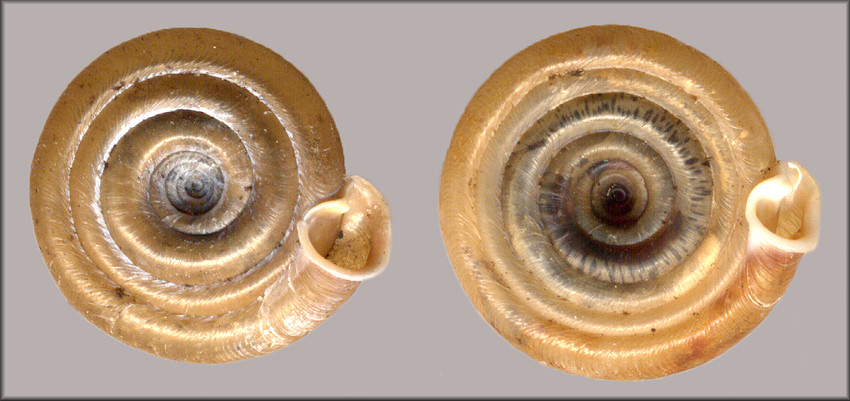|
Polygyra septemvolva Say, 1818 and Polygyra cereolus (Mühlfeld, 1816) Comparison |
|
|
|
|
|
Polygyra septemvolva Say, 1818 (12.2 mm.) |
Polygyra cereolus (Mühlfeld, 1816) (12.5 mm.) |
|
|
|
|
Giant Flatcoils; A Diagnostic Poser By Harry G. Lee Throughout their ranges, which overlap in much of peninsular Florida, the shells of Polygyra septemvolva Florida Flatcoil and P. cereolus Southern Flatcoil are usually fairly easy to distinguish. The former tends to grow larger and have a greater number of smaller caliber whorls. Furthermore its umbilicus appears more open, less funnel-shaped, than that of P. cereolus.In my experience the largest shells of P. septemvolva come from a corridor along or near the lower reaches of the St. Johns River. Here specimens exceeding 14 mm. in maximum diameter are occasionally found. I collected my biggest specimen in February, 2008 along with several similar ones near the boat ramp at Salt Run, in St. Augustine. This champion is a bleached dead-collected shell measuring 14.5 mm. comprised of 8.9 whorls by the Pilsbry (1939: xi) method. A most unusual suite of P. cereolus comes from John D. MacArthur State Recreation Area, North Palm Beach. The largest of these very large specimens measures 15.8 mm. in maximum diameter and is composed of 9.8 whorls. These were collected in August, 1999 by Phil Poland of Clearwater. Each of the pair of shells figured above was selected from one of these two suites of giant specimens based on similarity of size and coloration (L: P. septemvolva 12.2 mm.; R: P. cereolus 12.5 mm.). The specific distinction between these two shells (and lots) appeared at first to pose a problem, but it seems they may be differentiated by a single character, the morphology of the umbilicus, which feature is remarkably consistent within each lot (n=24; n=7 respectively). There appear to be two diagnostic salients: (1) In P. septemvolva there is a remarkable variation in the diameter of the exposed portions of the final few whorls - in the figured shells (and its lot-mates) most conspicuously in the vicinity of the antepenult, which appears to bulge (I like the term "prolapse," borrowed from medical jargon) abapically ("ventrally" to some). In contrast, the progression of the whorl diameter of P. cereolus in this zone, and elsewhere as revealed in this umbilical view, is more orderly. (2) the umbilical core, the innermost four or five whorls in each specimen, is more open (perspective) in P. septemvolva; P. cereolus, in contrast, has a steeper-sided and deeper (funicular) shape to its umbilical core. In more typical, much smaller and fewer-whorled, shells such as those featured elsewhere on the website, these features are less subtle, and other conchological characters cited in the first paragraph above are apparent as well. Nonetheless, the distinction of these two taxa continues to occupy the energies of malacologists and have actually been the subject of much discussion in the literature. Pilsbry, H.A., 1939. Land Mollusca of North America (north of Mexico) vol. 1 part 1. Academy of Natural Sciences, Philadelphia. xvii + pp 1-573 + ix. 6 Dec. |
|
